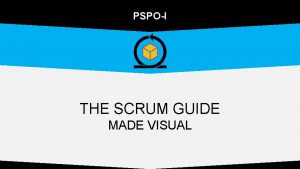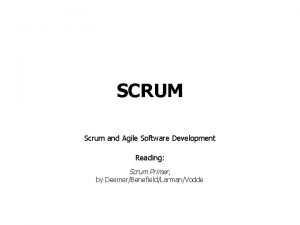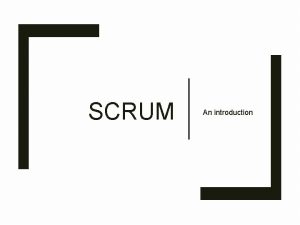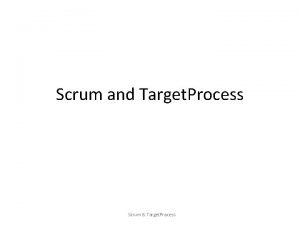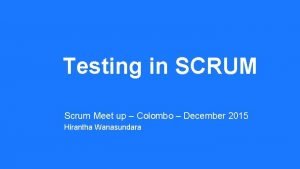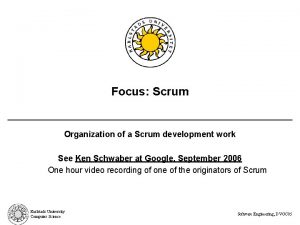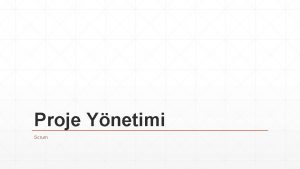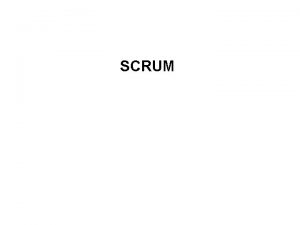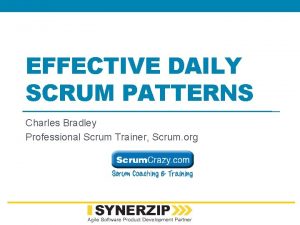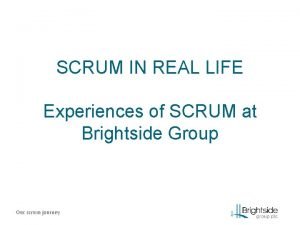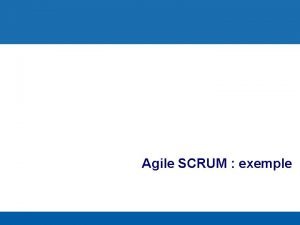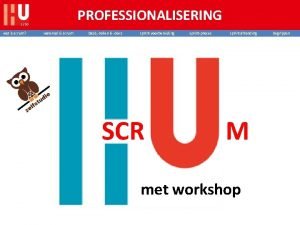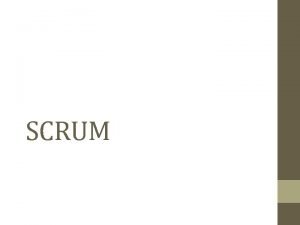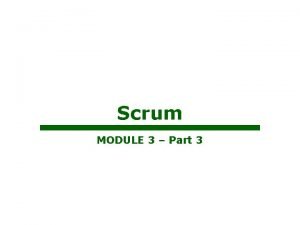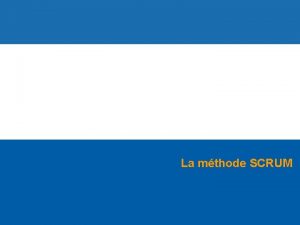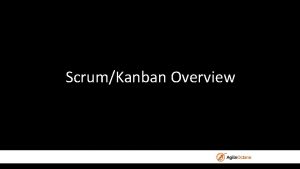PSPOI THE SCRUM GUIDE MADE VISUAL SCRUM GUIDE









































- Slides: 41

PSPO-I THE SCRUM GUIDE MADE VISUAL

SCRUM GUIDE TABLE OF CONTENT FRAMEWORK DEFINITION PILLARS VALUES TEAM EVENTS ARTEFACTS SPRINT 03 05 11 15 16 22 35 41

SCRUM Is a framework for: DEVELOPING DELIVERING COMPLEX PRODUCTS SUSTAINING

THE SCRUM FRAME Definition of Scrum consists of 3 items: ROLES EVENTS These items are bound by the rules ARTEFACTS of Scrum.

DEFINITION Scrum (n): a framework within which people can address complex adaptive problems, while productively and creatively delivering products of the highest possible value.

SCRUM Is… LIGHTWEIGHT SIMPLE TO UNDERSTAND DIFFICULT TO MASTER

SCRUM Is not A PROCESS A TECHNIQUE A DEFINITIVE METHOD

SCRUM Helps continuously improve: THE PRODUCT THE TEAM THE WORKING ENVIRONMENT

ESSENCE OF SCRUM A small team of people: 1 PRODUCT OWNER 1 SCRUM MASTER 3 - 9 DEVELOPERS

DEFINITION · Scrum is founded on empirical process control theory, or empiricism. · Empiricism asserts that knowledge comes from experience and making decisions based on what is known. · Scrum employs an iterative, incremental approach to optimize predictability and control risk.

EMPIRICAL PROCESS CONTROL Empirical process control rests on 3 pillars TRANSPARENCY INSPECTION : ADAPTATION

TRANSPARENCY · Significant aspects of the process must be visible to those responsible for the outcome. · Transparency requires those aspects be defined by a common standard.

INSPECTION · Scrum users must frequently inspect Scrum artefacts and progress toward a Sprint Goal .

ADAPTATION Adjust the process or the material being processed as soon as possible to minimize deviation thanks to four formal events for inspection and adaptation: SPRINT PLANNING DAILY SCRUM SPRINT REVIEW SPRINT RETRO.

SCRUM VALUES ARE COMMITMENT COURAGE FOCUS = TRUST + INDEPENDANCE OPENNESS RESPECT

1/3 THE SCRUM TEAM IS COMPOSED OF 1 PRODUCT OWNER 1 SCRUM MASTER DEV. TEAM

2/3 THE SCRUM TEAM Is… · Self-organized: the team chooses how best to accomplish its work. · Cross-functional: the team has all the competences needed to accomplish the work. This helps improve: FLEXIBILITY CREATIVITY PRODUCTIVITY

3/3 THE SCRUM TEAM Scrum teams deliver products iteratively and incrementally in order to maximize opportunities for feedback .

THE PRODUCT OWNER Is… · Only 1 person. · Responsible for maximizing the value of the product. · The sole responsible for managing the Product Backlog , including: · Clearly expressing Product Backlog items. · Ordering the items in the Product Backlog. · Optimizing the value of the work achieved by the Dev. Team. · Making sure the Product Backlog is visible, transparent and clear. · Making sure the Dev. Team understands the items in the Product Backlog . While the PO is responsible for theses tasks, the PO can delegate them to the Development Team, and he remains accountable for them.

THE SCRUM MASTER Is… · Only 1 person. · Responsible for promoting and supporting Scrum by helping everyone understand Scrum theory, practices, rules and values. · A servant-leader for the Scrum Team. · Helping channel interactions from outside the Scrum Team to avoid being disturbed/scattered. · Helping the team by providing tools and methods to facilitate the work and removing impediments.

THE DEVELOPMENT TEAM Is… · Composed of 3 to 9 developers. · Composed of professionals who do the work of delivering a potentially releasable Increment ‘Done’ product at the end of each Sprint. · Self-organizing. · Cross-functional. · Accountable as a whole for the work delivered by the team. · Responsible for estimating items in the Product Backlog. Has… · No title for members. · No sub-team (such as Quality Assurance, Architecture, Business Analyse). of a

SCRUM EVENTS SPRINT PLANNING SPRINT GOAL DAILY SCRUM SPRINT REVIEW SPRINT RETRO.

SCRUM EVENTS Each event is time-boxed

SCRUM EVENTS Each event individually and as part of the Sprint TRANSPARENCY are designed to enable critical transparency and inspection. INSPECTION

THE SPRINT · Once a Sprint begins its duration is fixed , meaning it can’t be shortened or lengthened. · Duration is up to 1 month (maximum) to reduce complexity, limit risk and ensuring inspection and adaptation. · Sprints have consistent durations throughout a development effort. · Goal is to create a ‘Done’ , useable and potentially releasable Product Increment. · During a sprint: · The Sprint Goal must remain unchanged. · Scope may be clarified and re-negotiated between the Product Owner and the Dev. Team.

CANCELLING A SPRINT · A Sprint can be cancelled before the Sprint duration is over. · Only the Product Owner has the authority to cancel a Sprint. · The only reason for a Sprint to be cancelled is if the Sprint Goal becomes obsolete. · Any Sprint Backlog item considered as ‘Done’ is reviewed. · Any Sprint Backlog item which is incomplete is re-estimated and put back on the Product Backlog

1/2 SPRINT PLANNING 8 H/1 M · In presence of the entire Scrum Team (PO+SM+DT) + invited experts. · Time-boxed , up to 8 hours for a Sprint of 1 month duration. > Usually up to 4 hours for a Sprint of 2 weeks duration. · It is the Scrum Master’s responsibility to ensure the event takes place.

2/2 SPRINT PLANNING 8 H/1 M · Sprint planning aims to answer: · What can be delivered in the Increment. · How will the work be achieved. · The Product Owner presents the objective of what the Sprint should achieve (not a Sprint Goal at this stage) and the Development Team forecasts the functionalities that will be developed in the timeframe. · Input of the meeting: · Product Backlog. · Product Increment. · Projected capacity of the Dev. Team. · Past performance of the Dev. Team. · Only the Dev. Team can assess what it can accomplish over the upcoming Sprint.

SPRINT GOAL · Each Sprint may be considered a project, and thus tends to accomplish something. · Each Sprint has a goal of what is to be built along, a design and flexible plan that will guide the work. · The Sprint Goal provides guidance as to why the Dev. Team is building the Increment. · The Scrum Team crafts the Sprint Goal during the Sprint Planning. · The selected Product Backlog items deliver one coherent function, which can be the Sprint Goal. · The Sprint Goal is an effort for the Dev. Team to work together rather than on separate initiatives. · The scope of the Sprint Backlog (list of Backlog items) can be renegotiated if it turns out the work is different than what the Dev. Team thought it would be to achieve the Sprint Goal.

PLAN TO DELIVER · The Dev. Team decides how it will build this functionality into a ‘Done’ product increment. · The Product Backlog items selected for the Sprint and the plan for delivering them is called the Sprint Backlog. · Work planned for the first days of the Sprint should be decomposed by the end of the Sprint Planning into units of 1 day or less. · The Dev. Team self-assigns the work to be done in the Sprint Backlog. · By the end of the Sprint Planning , the Dev. Team should be able to explain to the PO and SM how it intends to deliver the work and achieve the Sprint Goal.

DAILY SCRUM 15 M · Held every day of the Sprint, at the same time and place. · Is time-boxed to no longer than 15 minutes. · Only intended for the Dev. Team but Scrum Master can be present to ensure time-boxing is respected. · Purpose is for the Dev. Team to inspect the work done in the last 24 hours and plan the work to be done in the next 24 hours. · Purpose is to inspect the progress toward completing the work in the Sprint Backlog and optimise the probability of completion.

1/2 SPRINT REVIEW 4 H/1 M · Held at the end of a Sprint to inspect the increment and adapt the Product Backlog if necessary. · Time-boxed , up to a maximum of 4 hours for a Sprint of 1 month duration. > Usually up to a maximum of 2 hours for a Sprint of 2 weeks duration. · In presence of the Scrum Team and Stakeholders. · Purpose is to present the Increment done during the sprint, in order to get feedback from participants in order to optimize value. · Key stakeholders are invited by the PO.

2/2 SPRINT REVIEW 4 H/1 M · PO explains what Product Backlog items have been ‘Done’ and what has not been ‘Done’. · Dev. Team demonstrates the work that it has ‘Done’ and discuss the problems it faced. · The group collaborates on what to do next, to provide valuable input for the subsequent Sprint Planning. · The group reviews how the potential use of the product might have changed. · Result of the Sprint Review is a revised Product Backlog. · PO tracks the work remaining at every sprint review and compares with previous sprint to assess amount of work remaining.

SPRINT RETROSPECTIVE 3 H/1 M · Occurs after the Sprint Review. · Time-boxed , up to 3 hours for a Sprint of 1 month duration. · Opportunity for the Scrum Team to inspect itself and create a plan for improvements to be enacted during the next Sprint: · Inspect how the Sprint went in regards of people, relationships, process and tools. · Identify and order major items that went well and potential improvements. · Create a plan for implementing improvements. · Definition of ‘Done’ can be adapted during the Sprint Retrospective.

SCRUM ARTEFACTS Purpose of Scrum’s artefacts is to provide complete transparency and opportunities for inspection and adaptation. PRODUCT BACKLOG SPRINT BACKLOG INCREMENT DEFINITION OF DONE

1/2 PRODUCT BACKLOG · Constantly re-ordered list of everything that is known to be needed in the Product. · The single source of requirements, features, functions, enhancements and fixes. · Product Owner is responsible for the Product Backlog, including content, and ordering. · The Product Backlog evolves as the product and the environment in which it is/will be used evolve. · Each Product Backlog item has a description, an order, an estimate and a value and often provides test description (such as acceptance criteria) that will prove the completion as of ‘Done’. · Multiple Scrum Teams can work on the same Product , hence the same Product Backlog.

2/2 PRODUCT BACKLOG · Product Backlog refinement is the act of adding detail, estimates and order to Product Backlog items. · Product Backlog refinement is an ongoing process involving the Product Owner and the Dev. Team. · Refinement is supposed to consume no more than 10% of the capacity of the Dev. Team. · Higher ordered items are usually clearer and more detailed than lower ordered ones. · Items that can be addressed by the Dev. Team for a sprint to come are considered ‘Ready’ for selection in a Sprint Backlog.

SPRINT BACKLOG · Set of Product Backlog items selected for the Sprint, and a plan to deliver the Product Increment and realizing the Sprint Goal. · The Sprint Backlog is the list of all the work the Dev. Team identifies as necessary to meet the Sprint Goal. · The Sprint Backlog includes at least one high priority process improvement identified during the previous Retrospective meeting. · The Sprint Backlog emerges during a Sprint and is modified throughout the Sprint by the Dev. Team which can add new work to it. · Only the Dev. Team can change the Sprint Backlog during a Sprint. · It is a real-time picture of the work accomplished and to be accomplished by the Dev. Team during a Sprint.

INCREMENT · Is the sum of all the Product Backlog items completed during previous Sprints. · At the end of a Sprint , an Increment must be ‘Done’ , which means it must be in useable condition and meet the Scrum Team’s definition of ‘Done’. · Each Increment is additive to all prior Increments and thoroughly tested to ensure that all Increments work together.

DEFINITION OF DONE · Definition of ‘Done’ is used to assess when work is complete on the Product Increment. · When the definition of ‘Done’ is not a standard in the development organization, the Dev. Team of the Scrum Team must define what ‘Done’ is. · Various Scrum Teams working on the same Product can only have one definition of ‘Done’ and have to define it together.

SPRINT REPRESENTATION 6 5 4 1 2 3 8 7 9
 Artefacts scrum
Artefacts scrum Hemodynamics made incredibly visual
Hemodynamics made incredibly visual Pengertian pemrograman visual
Pengertian pemrograman visual Hát kết hợp bộ gõ cơ thể
Hát kết hợp bộ gõ cơ thể Ng-html
Ng-html Bổ thể
Bổ thể Tỉ lệ cơ thể trẻ em
Tỉ lệ cơ thể trẻ em Voi kéo gỗ như thế nào
Voi kéo gỗ như thế nào Thang điểm glasgow
Thang điểm glasgow Hát lên người ơi
Hát lên người ơi Các môn thể thao bắt đầu bằng tiếng bóng
Các môn thể thao bắt đầu bằng tiếng bóng Thế nào là hệ số cao nhất
Thế nào là hệ số cao nhất Các châu lục và đại dương trên thế giới
Các châu lục và đại dương trên thế giới Công thức tính độ biến thiên đông lượng
Công thức tính độ biến thiên đông lượng Trời xanh đây là của chúng ta thể thơ
Trời xanh đây là của chúng ta thể thơ Mật thư anh em như thể tay chân
Mật thư anh em như thể tay chân 101012 bằng
101012 bằng Phản ứng thế ankan
Phản ứng thế ankan Các châu lục và đại dương trên thế giới
Các châu lục và đại dương trên thế giới Thể thơ truyền thống
Thể thơ truyền thống Quá trình desamine hóa có thể tạo ra
Quá trình desamine hóa có thể tạo ra Một số thể thơ truyền thống
Một số thể thơ truyền thống Cái miệng nó xinh thế
Cái miệng nó xinh thế Vẽ hình chiếu vuông góc của vật thể sau
Vẽ hình chiếu vuông góc của vật thể sau Nguyên nhân của sự mỏi cơ sinh 8
Nguyên nhân của sự mỏi cơ sinh 8 đặc điểm cơ thể của người tối cổ
đặc điểm cơ thể của người tối cổ Thế nào là giọng cùng tên? *
Thế nào là giọng cùng tên? * Vẽ hình chiếu đứng bằng cạnh của vật thể
Vẽ hình chiếu đứng bằng cạnh của vật thể Tia chieu sa te
Tia chieu sa te Thẻ vin
Thẻ vin đại từ thay thế
đại từ thay thế điện thế nghỉ
điện thế nghỉ Tư thế ngồi viết
Tư thế ngồi viết Diễn thế sinh thái là
Diễn thế sinh thái là Dạng đột biến một nhiễm là
Dạng đột biến một nhiễm là Số nguyên tố là gì
Số nguyên tố là gì Tư thế ngồi viết
Tư thế ngồi viết Lời thề hippocrates
Lời thề hippocrates Thiếu nhi thế giới liên hoan
Thiếu nhi thế giới liên hoan ưu thế lai là gì
ưu thế lai là gì Khi nào hổ mẹ dạy hổ con săn mồi
Khi nào hổ mẹ dạy hổ con săn mồi Sự nuôi và dạy con của hổ
Sự nuôi và dạy con của hổ
